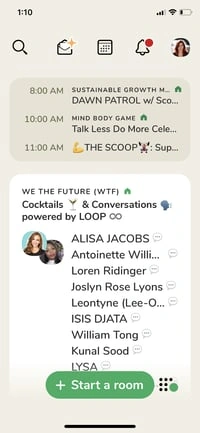Clubhouse was launched in March 2020 by Paul Davison, who previously worked at companies including Pinterest and Google, and Rohan Seth, a former Google engineer. According to a post from Davison and Seth, Clubhouse was created after a handful of social media app experiments.
"After a lot of iteration in the audio space, we launched Clubhouse in March of last year," the co-founders wrote.
"Our goal was to build a social experience that felt more human—where instead of posting, you could gather with other people and talk. Our north star was to create something where you could close the app at the end of the session feeling better than you did when you opened it, because you had deepened friendships, met new people, and learned,"the post explained.
Initially, Clubhouse was marketed to top-tier influencers, celebrities, Silicon Valley investors, and industry thought leaders, but recently opened to more general audiences. A few of the app's first high-profile users include Drake, Daymond John, Elon Musk, and Oprah Winfrey. Early on, these notable users were heard chatting in Rooms related to their interests, hobbies, causes, or industries.
Despite Clubhouse's exclusivity, it was valued at $100 million and received a $12 million investment from Andreessen Horowitz within a year of its launch.
Most recently, Clubhouse has begun to give access to a larger pool of users by allowing each new member to invite two friends of their own. This has caused the user base to jump from 600,000 active users in December 2020 to more than 10 million today.
"This past week, two million people around the world—musicians, scientists, creators, athletes, comedians, parents, entrepreneurs, stock traders, non-profit leaders, authors, artists, real estate agents, sports fans, and more—came to Clubhouse to talk, learn, laugh, be entertained, meet and connect. It’s the most exciting thing we’ve ever been a part of," wrote the Clubhouse team in a Jan. 24 blog post.
Why Many Marketers Are Just Learning About Clubhouse
Just hearing about Clubhouse now? You aren’t alone.
As mentioned, Clubhouse was initially targeted to high-profile industry "elites," such as celebrities, CEOs, and top online influencers. For a while, these types of users were the only ones who could send and receive Clubhouse invites. On top of the app’s invite-only nature, it's only available to iPhone users.
While Clubhouse's early exclusivity made it interesting and alluring to the every-day social media user, it caused the app's awareness and user-base to grow at a slow but steady pace.
Now that the app's become more accessible to social media users, it's been getting more awareness online and across news media. At this time, marketers are also starting to wonder if and how they could use Clubhouse -- or something like it -- in their strategy.
In fact, many professionals, business leaders, and non-profit members can already be heard speaking in Rooms that discuss a topic related to their brand, industry, or mission.
For example, a recent Room I dropped in on featured a group of lawyers aiming to offer education around patent protection. While this content was intriguing to listeners, it also could have brought each lawyer’s firm more awareness:

Aside from marketers, major social media companies are also trying to take advantage of Clubhouse's audio social media trends.
Shortly after Facebook CEO Mark Zuckerberg spoke in a Clubhouse Room, the New York Times reported that his social media company was allegedly building a similar audio platform. Meanwhile, Twitter just began rolling out Twitter Spaces -- a drop-in audio feature with its app -- to a small group of beta testers.
At the moment, Clubhouse seems like a promising way to network and build a community online, and its audio social format is already being adopted by competitors. However, in a time where we see a handful of new online platforms each year, is Clubhouse really a game-changer in the social media space? Or is it just another over-hyped app you shouldn't waste your marketing efforts on?
Below, I'll give a brief description of how the platform works and then weigh the pros and cons of using Clubhouse for marketing.
How Clubhouse Works
While we'll be publishing a detailed how-to guide for the Clubhouse platform, which we'll link to in this post later, here's a quick description of how some of the major features work.
Clubhouse's Main Tabs
When entering Clubhouse, users will find a homepage that highlights ongoing Rooms related to their interests or followers. They’ll also find search, message inbox, calendar, and notification icons in the upper navigation.

When tapping the search or "Explore" tab, users can scroll through a feed of suggested Rooms, Clubs, or people to follow. They can also use the search bar to find specific individuals or Clubs. However, it does not seem like users can search for specific Rooms yet.

If users can’t attend a Room when they're surfing the Clubhouse app but would like to drop into one later, they can tap the calendar icon.to see or create their scheduled Rooms.

Clubhouse Rooms
Entering a Room is essentially like attending a webinar or Zoom meeting with no video and a partially muted audience.
Attendees, who can join or leave a Room at any time, enter (or drop-in) as automatically muted listeners. If they'd like to speak or ask questions, they can tap the "Raise Hand" icon in the lower right corner of the Room page. Room moderators will then be notified of the hand raise request and can ignore it or unmute the attendee.
Below is a look at what Clubhouse Rooms look like:

Visually, attendees of the Room can see only the profile photos and names of current participants, with moderators and speakers appearing at the top of the screen.
Users and moderators can also add people they follow to a Room by tapping the "+" button in the lower navigation. This gives their friends a notification that they've been invited to a Room and enables them to open the app and join it directly.
Starting a Room
At the bottom of the homepage, users can also tap "Start a Room" to launch either a "Closed" chat open to specific people only, a "Social" chat open to all of a user's following, or an "Open" chat that anyone on Clubhouse can drop into.

Users can also tap the nine-dot icon on the lower homepage navigation to have a private audio chat with specific followers who are online.

Room moderators, who either launched the Room or were assigned to a moderator role after the Room launched, see a similar page that attendees see. However, they also get notifications of new Room attendees and a list of attendees who have raised their hand requesting to speak.
One interesting thing to note is that a Room only ends when a moderator ends it or when the final moderator leaves it. Additionally, moderators who want to leave a Room without ending it can assign someone else to become a moderator. This means that a Room with multiple moderators can go on for hours or even days.
Because of how long Rooms last, and the fact that attendees can join or exit whenever they want, you might regularly hear more seasoned Room moderators re-introduce themselves, what they’re discussing, and who else is speaking throughout a Room event.
Clubs and Networking
Aside from creating Rooms, users can also follow individual profiles of friends, influencers, or thought leaders in their industry.
They can also join or create Clubs, which are groups of users with interest in specific topics, hobbies, or industries. Take a look at some of the Clubs that appeared when I searched, "growth marketing."

Once users join a Club, they can be notified if a Club's manager launches a Room related to its core topic. For example, if I were to join one of the Growth Marketing Clubs shown above, I'd be instantly notified if they hosted a Room on a growth marketing tactic.
Want another example of a club to join? Check out and follow HubSpot's Marketing Club to be notified about our latest rooms.
The Pros and Cons of Clubhouse.
Pros of Using Clubhouse
1. Clubhouse could help brands build trust and community.
Of late, consumers generally favor companies with authentic, trustworthy messaging over big-name companies with decades of brand loyalty. This shift will likely continue.
Why? In a time of financial uncertainty and constant news events, consumers want to know that brands care about their customers and share values with them. While creating a live, uncensored, unscripted Room related to your brand's industry might sound nerve-wracking, it could help some brands seem more authentic and trustworthy.
"Clubhouse offers a lot of opportunities for connection with celebrities, a vast variety of people in different industries, and even close friends," says Krystal Wu, HubSpot's social media community manager. "It opens the door for live conversations allowing people to be vulnerable within a community space. This type of connection is unique to deliver audio content with small to large groups of people. Its unscripted content that anyone can be a part of.”
Brands that use Clubhouse could earn credibility by discussing topics they're experts on. But, they could also earn trust because they've made themselves available to listen and talk candidly with their audiences.
2. The app's content is always evolving.
While the app initially hosted conversations related to entertainment, business, and technology due to its initial target audience, the audio content on the platform has broadened and evolved
In fact, CNBC recently reported that some of Clubhouse's most engaging Rooms have been launched by innovative Black creatives who've done heavy experimentation on the platform.
For example, instead of hosting a chat or discussion, one group of Black performers hosted an audio-only production of Disney's "The Lion King."
While there isn't a recording of the Clubhouse performance, led by Noelle Chesnut Whitmore, Kam DeLa and Bomani X, here's a screenshot from the event, which shows each Room moderator as the character they played:

"What started as a random conversation on Clubhouse has scaled to something much greater. We have so many talented people contributing their time and energy to this performance,"Whitmore said in a press release. "Our goal is just to spread some joy to people through these events. I never imagined this would get such a huge response."
In another example, a cocktail brand called Loop hosted a Room that encouraged participants to have a cocktail and join a casual conversation with no specific topic. While this strategy is less structured, it enables people who want to learn more about the brand or just want to chat with other cocktail drinkers to connect.

Because Clubhouse is fairly new, there aren't major content-related expectations just yet. This means that anyone from any group, industry, non-profit, or brand can experiment with it and learn what's truly engaging to the app's growing audience.
3. The app is primed for thought leadership.
Clubhouse's user base was built around influencers and thought leaders. This means that users are likely coming to the app to hear the latest tips, exclusive information, or discussions straight from industry experts.
For example, the scheduled Room shown below features Coinbase Co-Founder and CEO Brian Armstrong.

In a Clubhouse Room like the one shown above, users could learn more about a brand like Coinbase and ask its leader questions about the company or its industry. Through Rooms like this, Coinbase and other brands could boost both company awareness and credibility with audiences who listen.
4. Audiences want online communities and audio content.
In the last year, people who were stuck at home turned to webinars, virtual events, and other online experiences to learn more about their interests, hear from others in their industry, or just feel a sense of connection to people outside of their households.
But, while virtual events were beneficial for many, most of us eventually dealt with screen fatigue.
Because too much screentime can be mentally draining, consumers also checked out podcasts or camera-free webinars. Now, these audiences could be primed for Clubhouse's audio-only nature.
"Clubhouse’s most appealing quality is that it's a break from the nonstop screen time we all exist in," says Kelly Hendrickson, HubSpot social media marketing manager. "Clubhouse is also a wonderful place to have conversations among niche communities and topics."
And, while consumers are craving personal connections and live content more than ever, many brands are trying to build stronger online communities and launch effective digital event strategies.
Ultimately, Clubhouse's audio-only layout could help brands meet and build an engaged community of fans on an interactive, authentic, and live platform.
Cons of Clubhouse
1. The app still has limited audiences.
Ultimately, one of Clubhouse's biggest brand marketing flaws is also what makes it so intriguing: exclusivity.
"I am generally against anything that is invite-only as it creates a culture of 'others'," Hendrickson says. "Any time you need to be 'in the know' to have a seat at the table, how can you also be inclusive?"
While Clubhouse might pose unique group chat opportunities for community marketers when more people join, the audiences might still be too limited for some marketers at the moment. On top of this, the app is still unavailable to Android users.
“Clubhouse actually hinders its capabilities because there are many talented potential users out there that are missing out all because they are on Android,” Wu says.
If you're looking to only create content for the largest audiences possible, you might want to hold off on building a Clubhouse strategy right now. However, if you're only looking to experiment and see if you can reach the audiences it already has, it might be an interesting platform for your team to try.
2. Clubhouse could have strong audio-app competition.
Facebook and Twitter could be just the first platforms to create a similar audio drop-in experience. And, while this hints that Clubhouse creators have stumbled upon a platform many social media users want, the big-name competition could also pose concerns about the platform's future.
For example, if Facebook or another major competitor can create something similar that's less exclusive and allows iPhone and Android users, people might leave Clubhouse for a platform with a larger audience or more credibility in the social media world. If this happens, marketers who invest heavily in a Clubhouse strategy might need to do a sudden pivot.
While this shouldn't scare you away from testing the platform if you think it's right for your brand, the competition is still important to keep in mind. If you are considering Clubhouse, continue to follow its competitors and determine how you could pivot your strategy to those platforms if your audiences start to flock there instead.
3. Clubhouse can feel like an "unedited podcast."
"Another challenge I think brands and individuals will have with Clubhouse is how it feels like an unedited podcast," says Hendrickson. "That means you’re hearing all the great meat, but you also have to listen to the trimmings. It will be interesting to see if long term, people are okay with that in their content."
If you're planning to experiment on Clubhouse, consider practicing a few conversation starters, how you'll enter the call, and determine what you'll do if you run into dead air, boring conversation, or off-topic discussion that draws attention away from your Room's goal.
Although Rooms are live and unscripted, having a gameplan will help you moderate an effective, higher-quality conversation than users might find in other Rooms.
4. Brands could be too vulnerable.
Certain generations, like Gen Z, crave authenticity from people and brands they follow on social media. With an app like Clubhouse, brands could create Rooms or Clubs related to their industry that include thought leaders, prospects, and even clients that want to talk with them in a live, unfiltered way.
However, while Clubhouse's high level of unscripted authenticity has intrigued both marketers and prospective users, it also could put brands in vulnerable positions. Wu describes this as “a balance between good and evil.”
Within a year of its launch, Clubhouse's live nature has already led to brand-related controversies.
For example, in February, Elon Musk, CEO of Tesla and SpaceX, dropped into a Room with Robinhood Markets CEO Vlad Tenev and raised his hand. When he was invited to speak by the Room's moderators, Musk began intensely questioning Tenev and asked him to explain why his stock-trading company stopped its users from buying and selling GameStop and other manipulated stocks. You can hear the line of questioning in the video below:
While Robinhood's CEO remained calm and collected throughout the chat, some brands might not have well-trained speakers who would react as calmly or professionally to this surprising scenario.
Additionally, although Clubhouse doesn't allow users to record, many either downloaded screen-recording apps or filmed their phones with another video recording device. Because of this, Musk and Tenev's conversation was covered by the media within hours.
Even though conversations cannot be replayed or recorded in the Clubhouse app itself, marketers on the app must remember that they're live and anything they say could easily be streamed or quoted in seconds. Because of this, Room hosts should prepare themselves so that they can answer both easy and challenging questions from audience members. Moderators should also determine what they'll do or how they'll react if an unmuted audience member says something controversial or unexpected.
Is Clubhouse right for you?
In its current state, Clubhouse could offer some major awareness and community-building benefits to brands. But, because of how new it is, it also poses some challenges and cons to companies that want to reach the largest audiences possible. Ultimately, while some companies might thrive on it, others might realize that it isn't the best platform for their goals just yet.
As with any new social media platform, you'll want to spend some time on Clubhouse and see what the app has to offer before putting time and effort into using it.
At this point, it could be wise to see if one of your friends or colleagues can send you a Clubhouse invite so you can familiarize yourself with the app. If you can't log on, be sure to continue following the news around it.
As you surf through the app or read Clubhouse news coverage, ask yourself questions like these:
- Are topics related to your product or industry widely discussed on the platform?
- Are there any thought leaders or company experts you could host a panel or two with to boost your awareness or credibility on Clubhouse?
- Are our competitors using Clubhouse? And, if so, can we create stronger Room experiences than they can?
- Do you already use marketing strategies that could be adapted to an audio-only platform, such as live video Q&As, webinars, or virtual events?
With questions like those above, you can determine if you'll be able to create scalable and engaging content for this social media platform.
Can't get access to Clubhouse just yet? Don't worry. We'll continue to cover it on the HubSpot Blog so you'll be ready when you do.
Editor's Note: This blog post was originally published Feb. 17, 2021, but was updated to add more HubSpot video coverage of Clubhouse on March 29, 2021.
Social Media Marketing




![12 social media trends marketers should watch in 2025 [new data]](https://53.fs1.hubspotusercontent-na1.net/hubfs/53/social-media-trends_6.webp)
![The best social media platforms for video content in 2025 [consumer data]](https://53.fs1.hubspotusercontent-na1.net/hubfs/53/img-1-20250516-9399498.webp)


.png)
![Social media shopping in 2025: Everyone’s shopping on social — here’s how marketers can keep up [new data]](https://53.fs1.hubspotusercontent-na1.net/hubfs/53/1052%20x%20850%20social%20media.jpg)


![Best Social Media Marketing Courses to Take Online [Free & Paid]](https://53.fs1.hubspotusercontent-na1.net/hubfs/53/ft-smm.webp)